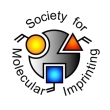Authors: Lim GW, Lim JK, Ahmad AL, Chan DJC
Article Title: Molecularly imprinted polymer layers using Navicula sp. frustule as core material for selectively recognition of lysozyme.
Publication date: 2015
Journal: Chemical Engineering Research and Design
Issue: (0)
DOI: 10.1016/j.cherd.2015.06.005
Alternative URL: http://www.sciencedirect.com/science/article/pii/S0263876215002105
Abstract: Surface molecular imprinting onto supported materials is particularly suitable for bulky structure template like protein. Inspired by this method, diatom frustules (Navicula sp. frustules) were used for the first time as supported material due to its unique properties of moderate surface area, reproducible with exactness in vast numbers and biocompatible, in order to address the limitation of nanoparticle as core material with low adsorption capacity. The molecular imprinting on Navicula sp. frustules was synthesized using polyacrylamide incorporate with two charged monomers and LYZ as template. The effect of synthesis conditions such as molar ratio of monomers and feed crosslinking degree were examined. With the optimal crosslinking degree (50%) and molar ratio of monomers (1/0.5/0.5), the LYZ-imprinted frustules exhibited enhancement in both rebinding capacity (124 -¦ 1.09 mg g-1) and imprinting factor (2.99), without showing significant decrease in adsorption kinetics (within 15 minutes) when compared to work of other research groups. Additionally, template removal during LYZ-imprinted frustules synthesis as well as desorption after rebinding was achieved via mildly washing with salt solution. The outstanding recognition, rebinding and desorption performance suggested that Navicula sp. frustules are potential core material for surface molecular imprinting in the application of medical diagnostics
Author keywords: surface molecular imprinting, Navicula sp.frustules, Lysozyme, Selectively protein recognition



Join the Society for Molecular Imprinting

New items RSS feed
Sign-up for e-mail updates:
Choose between receiving an occasional newsletter or more frequent e-mail alerts.
Click here to go to the sign-up page.
Is your name elemental or peptidic? Enter your name and find out by clicking either of the buttons below!
Other products you may like:
 MIPdatabase
MIPdatabase









